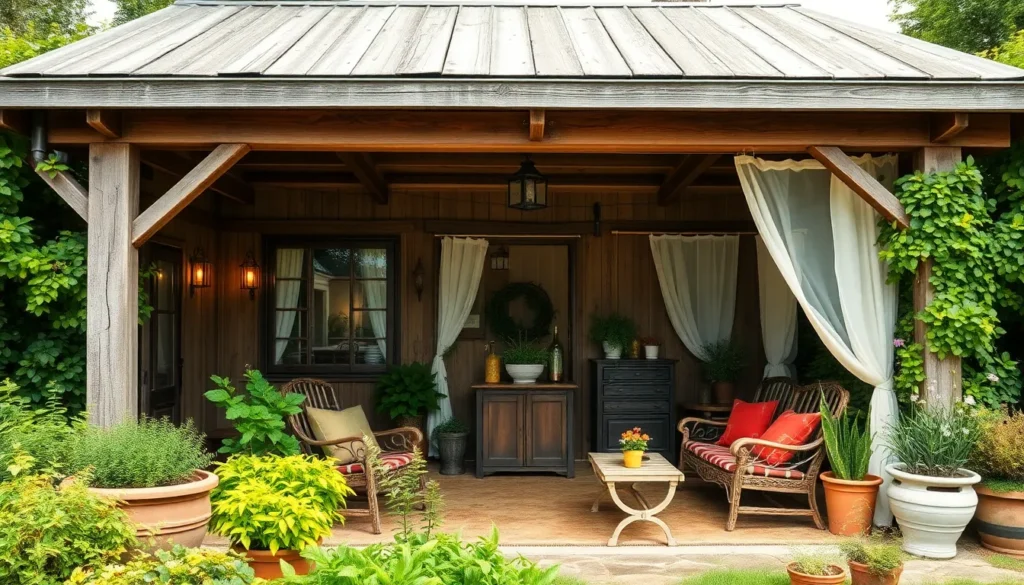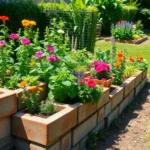Transforming your outdoor space into a stunning garden veranda can completely revolutionize how you experience your home. We’ve discovered that the perfect veranda seamlessly blends indoor comfort with outdoor beauty, creating an inviting retreat where you’ll want to spend countless hours relaxing and entertaining.
Whether you’re working with a sprawling backyard or a compact urban space, we know there’s a veranda design that’ll suit your style and budget. From cozy cottage-inspired setups with climbing roses to sleek modern designs featuring minimalist planters, the possibilities are endless.
We’re excited to share our favorite garden veranda ideas that’ll help you create an outdoor oasis you’ll absolutely love. These practical yet beautiful concepts will transform any ordinary porch or patio into a stunning garden sanctuary that adds value to your home while providing the perfect escape from daily stress.
Create a Classic Wraparound Veranda Design
Classic wraparound verandas embody timeless elegance that transforms your garden space into a sophisticated outdoor retreat. We’ll explore the essential elements that make these designs both functional and visually stunning.
Traditional Railing Options
Spindle railings offer the most authentic Victorian charm with their vertical wooden balusters spaced evenly between top and bottom rails. We recommend using cedar or pressure-treated pine for durability, with spindles measuring 2 inches by 2 inches for optimal strength. Lattice panel railings create visual interest while maintaining the classic aesthetic, featuring diagonal or square grid patterns that allow partial views of your garden below.
Solid board railings provide maximum privacy and weather protection, typically constructed with 1-inch by 6-inch horizontal boards or tongue-and-groove planking. These designs work particularly well for wraparound verandas facing busy streets or neighboring properties. Combination railings blend different elements like solid lower sections topped with spindle or lattice upper portions, offering both privacy and airflow at heights ranging from 36 to 42 inches.
Column Styles and Materials
Round columns create the quintessential wraparound veranda look, available in diameters from 8 to 12 inches depending on your structure’s load requirements. We prefer fiberglass or composite materials for their weather resistance and low maintenance needs compared to traditional wood options. Square columns offer a more contemporary take on classic design, typically measuring 8 inches by 8 inches or 10 inches by 10 inches for standard residential applications.
Tapered columns add architectural sophistication with their wider base gradually narrowing toward the top, creating visual appeal while maintaining structural integrity. Craftsman style columns feature wider bases with decorative caps and often incorporate stone or brick pedestals that extend 2 to 3 feet from the ground. These materials include cedar, mahogany, or engineered wood products that resist warping and splitting over time.
Roof Configurations
Hip roof designs provide complete weather protection by sloping on all four sides, creating the traditional wraparound appearance that shields your veranda from rain and sun. We recommend a minimum 8-foot ceiling height to ensure comfortable headroom while maintaining proper proportions. Shed roof configurations work well for partial wraparound designs, featuring a single slope that directs water away from your home’s foundation.
Gabled roof sections add architectural interest by incorporating triangular peaks at key points along the wraparound structure. Metal roofing materials like standing seam steel or corrugated panels offer durability and complement the classic aesthetic while providing excellent water runoff. Asphalt shingles remain the most cost-effective option, with architectural styles mimicking slate or wood shake patterns for enhanced visual appeal.
Design a Modern Minimalist Garden Veranda
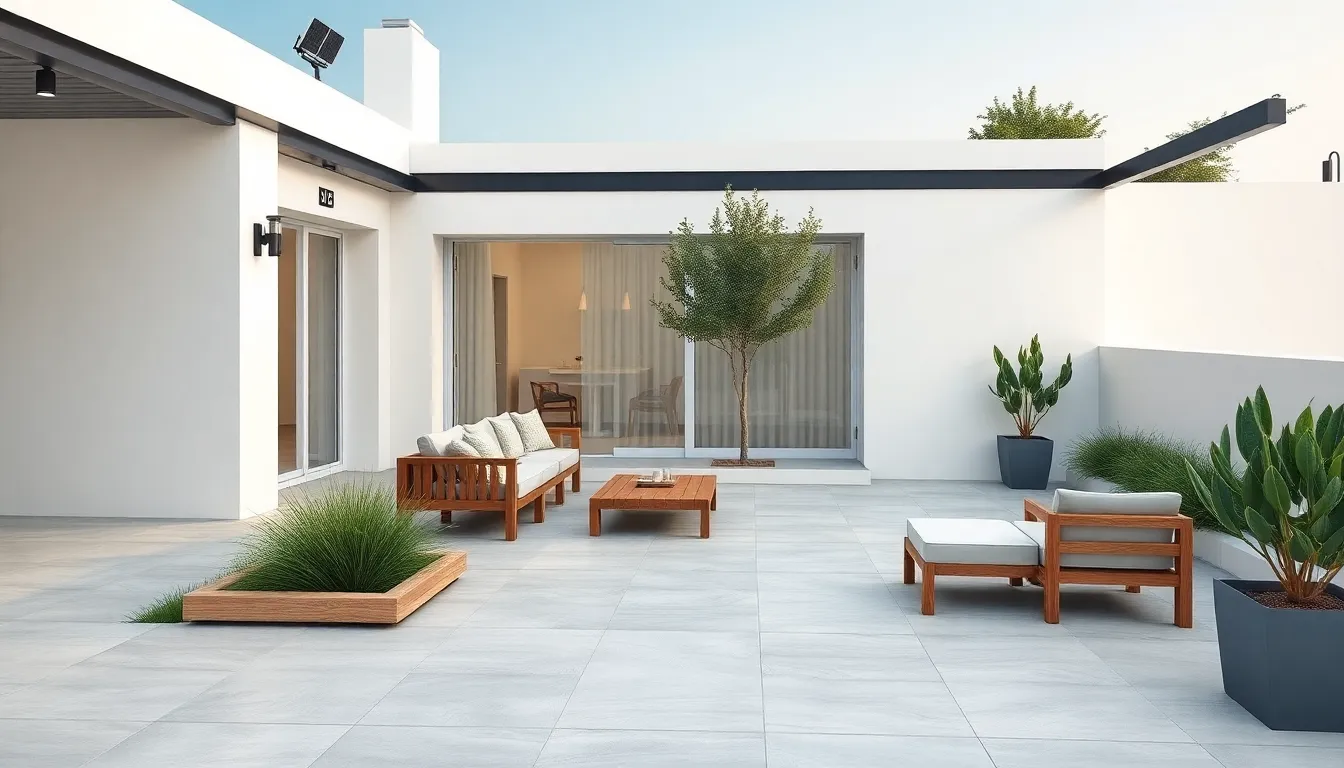
Moving from traditional designs to contemporary aesthetics, we’ll explore how minimalist principles can create a sophisticated outdoor space. Modern minimalist garden verandas focus on simplicity, functionality, and visual harmony to achieve maximum impact with minimal elements.
Clean Lines and Geometric Shapes
Geometric platforms serve as the foundation for minimalist garden veranda design, with rectangular or square deck configurations creating visual order and spatial clarity. We recommend incorporating clean metal railings that follow straight lines and angular patterns to maintain the structured aesthetic throughout your space.
Sculptural grass arrangements and strategically placed olive trees add organic movement without overwhelming the clean design philosophy. These natural elements provide visual interest while respecting the minimalist approach to outdoor living.
Geometric outdoor rugs help define conversation areas and seating zones, using patterns like stripes, blocks, or simple grid designs to reinforce the angular theme. We suggest choosing rugs in neutral tones that complement rather than compete with your veranda’s architectural elements.
Contemporary Material Choices
Light gray concrete decking provides the perfect foundation for modern minimalist verandas, offering durability and a sophisticated color palette that works with various design elements. This material choice creates a seamless connection between indoor and outdoor spaces while maintaining the clean aesthetic we’re aiming for.
Crisp white walls paired with sleek teak furniture establish a bright and open atmosphere that defines contemporary minimalist design. We find this combination particularly effective because it maximizes natural light reflection while providing warmth through the wood’s natural grain.
Metal and glass elements elevate the minimalist aesthetic through their clean surfaces and modern appeal. Floating glass features like pool houses or partition walls create functional spaces without visual weight, while metal accents in railings or furniture frames add structural interest.
Integrated Lighting Answers
Layered lighting systems enhance your minimalist veranda’s ambiance through strategic placement of path lighting, ambient fixtures, and accent spotlights. We recommend focusing on exact features like sculptural plants or architectural details to create visual depth without cluttering the space.
Solar powered options reduce energy consumption while supporting sustainable design principles that align with minimalist values. These fixtures eliminate the need for complex wiring systems and maintain the clean aesthetic by reducing visible infrastructure.
LED strip lighting integrated into railings or beneath seating areas provides subtle illumination that highlights geometric shapes and clean lines after dark. We suggest using warm white temperatures to maintain the inviting atmosphere while preserving the modern minimalist character of your garden veranda.
Build a Rustic Farmhouse Style Veranda
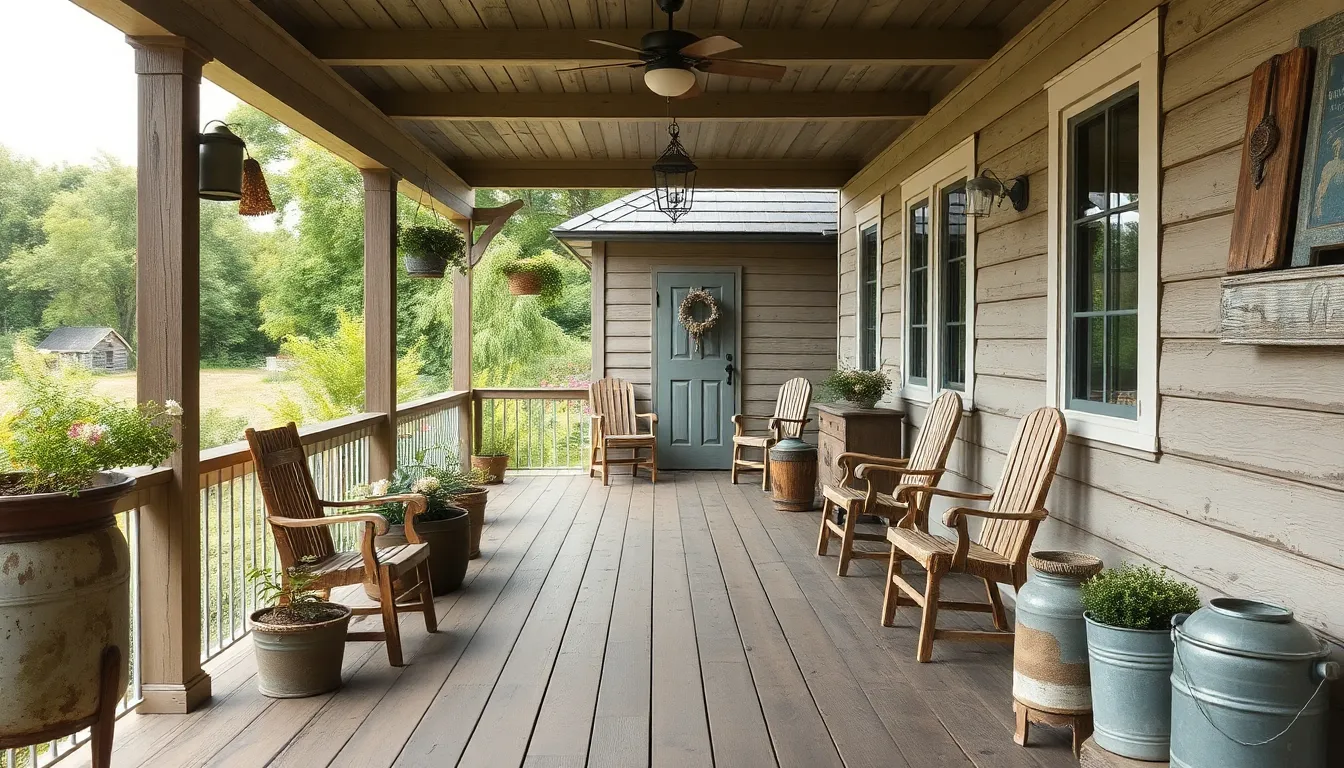
Rustic farmhouse style verandas bring authentic country charm to your outdoor space through weathered materials and vintage inspired elements. We’ll show you how to create this timeless look using reclaimed wood features, carefully curated vintage decor, and earth toned color palettes.
Reclaimed Wood Elements
Reclaimed wood forms the foundation of an authentic farmhouse veranda design. We recommend using salvaged wood for flooring, railings, and primary structural elements to achieve that weathered, lived in appearance that defines rustic charm. Accent pieces like side tables, planters, and wall decorations crafted from reclaimed materials add both function and visual interest to your space.
Consider incorporating different wood textures and finishes throughout your veranda design. Weathered barn wood creates stunning feature walls, while distressed pine planks work beautifully for flooring applications. Salvaged fence posts transform into unique railing supports, and old wooden crates serve as versatile storage answers or plant displays.
Mix various reclaimed wood tones to create visual depth without overwhelming the space. Light weathered oak pairs perfectly with darker walnut accents, while cedar elements add natural warmth and aromatic qualities to your farmhouse veranda.
Vintage Decorative Features
Vintage decorative elements bring authentic farmhouse character to your veranda through carefully chosen antique and vintage inspired pieces. We suggest using old milk cans as unique planters, antique farm tools as compelling wall art, and weathered wooden signs featuring inspirational quotes or rural imagery. Mismatched vintage chairs create charming seating arrangements that feel naturally collected over time.
Seasonal decorations keep your farmhouse veranda fresh and inviting throughout the year. Pumpkins and gourds create perfect fall displays, while fresh flowers in vintage mason jars bring spring energy to the space. Vintage tableware displayed on open shelving adds practical storage with nostalgic appeal.
Distressed furniture finishes enhance the lived in farmhouse aesthetic we’re creating. Chippy paint on wooden benches, rust patina on metal accents, and worn leather cushions all contribute to that authentic country feeling. Galvanized metal buckets serve dual purposes as planters and decorative storage answers.
Country-Inspired Color Schemes
Country inspired color palettes create the foundation for your rustic farmhouse veranda’s welcoming atmosphere. We recommend using muted earth tones like sage green, dusty blue, and warm terracotta to establish that cozy rural charm. These colors work harmoniously together while reflecting the natural industry surrounding traditional farmhouses.
Classic farmhouse patterns add visual interest without overwhelming your space. Buffalo check throws and pillows bring traditional country style, while ticking stripes on cushions create subtle texture variations. Gentle floral patterns in muted tones connect your veranda to the surrounding garden industry.
Accent colors should complement your primary palette while adding personality to the design. Cream and soft white create fresh contrast against darker wood elements, while deep barn red accents add authentic farmhouse character. Natural linen textures in neutral tones provide comfortable seating options that blend seamlessly with your rustic color scheme.
Incorporate Mediterranean Veranda Elements
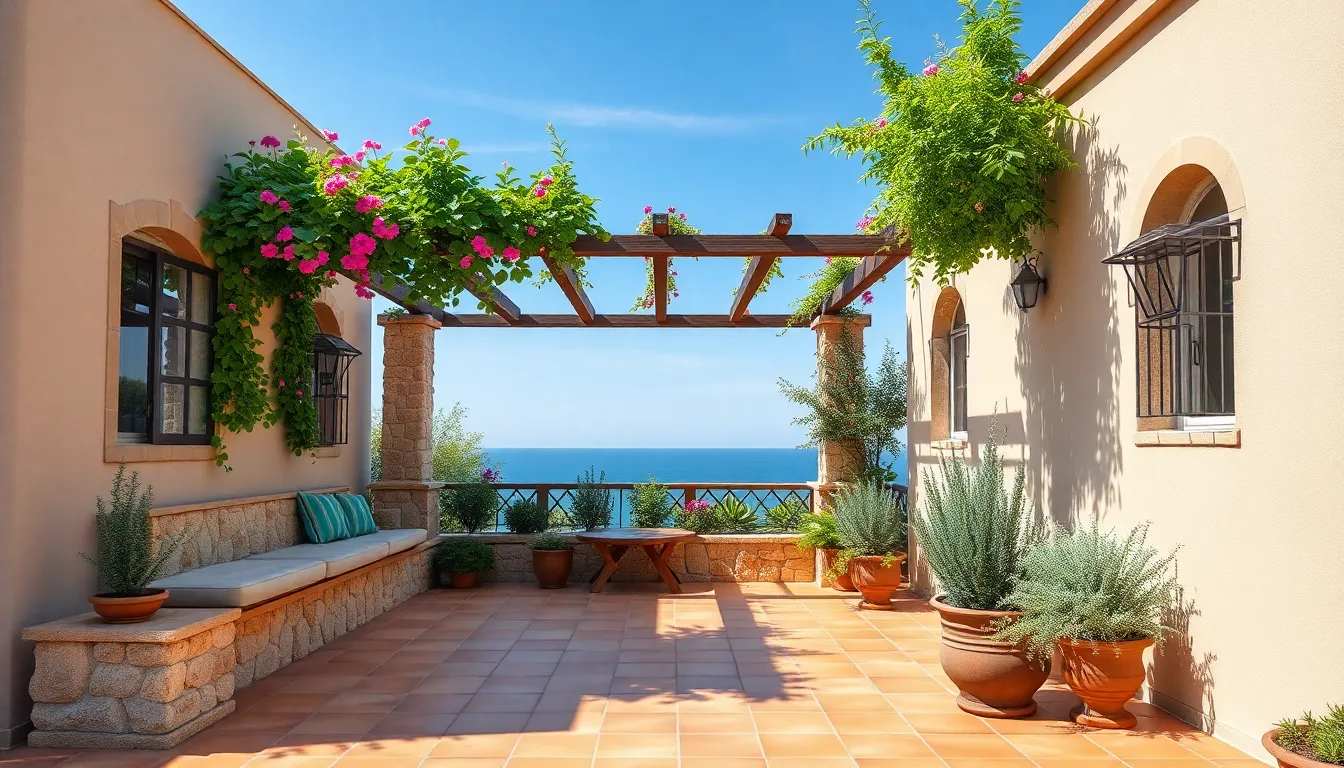
Building on our rustic farmhouse charm, we can transform our garden veranda into a sun-soaked Mediterranean oasis that captures the timeless elegance of coastal European living. Mediterranean design brings warmth and sophistication through carefully chosen materials and authentic architectural elements.
Terracotta and Stone Accents
Terracotta and stone create the perfect foundation for Mediterranean veranda design through their natural warmth and authentic textures. We recommend incorporating terracotta tiles for flooring areas to establish that classic Mediterranean base, while decorative terracotta planters add vertical interest and house our favorite Mediterranean plants. Stone accents work beautifully for seating walls that provide both function and visual appeal, creating natural gathering spots throughout the veranda space.
Color coordination plays a crucial role in achieving authentic Mediterranean style. We suggest choosing pale, sun-washed colors that complement Mediterranean plant hues, creating a harmonious palette that feels both sophisticated and relaxed. Stone pathways connecting different veranda areas add structure while maintaining the organic feel that makes Mediterranean spaces so inviting.
Pergola and Trellis Integration
Pergolas and trellises serve as essential structural elements that provide both shade and support for climbing plants, improving the sense of enclosure and intimacy that defines Mediterranean outdoor living. We love using these features to create shaded areas perfect for dining or relaxation while supporting beautiful climbing plants like vines or bougainvillea that add color and fragrance to the space.
Design variations allow us to customize the look while maintaining Mediterranean authenticity. Wooden frames offer traditional warmth and can weather beautifully over time, while metal frames add a touch of modernity without compromising the classic aesthetic. These structural elements become focal points that define different areas of the veranda while providing practical benefits like sun protection and privacy.
Herb Garden Combinations
Herb gardens bring both beauty and functionality to Mediterranean veranda designs through their aromatic presence and culinary value. We recommend incorporating heat-tolerant herbs like thyme, sage, oregano, and rosemary that thrive in Mediterranean climates and are staples in traditional Mediterranean cooking. These herbs not only survive hot conditions but actually develop more intense flavors when grown in sunny, warm locations.
Layout flexibility makes herb integration simple and effective in veranda designs. Decorative pots allow us to create portable herb gardens that can be rearranged seasonally, while integrated industry plantings blend herbs seamlessly with other Mediterranean plants for a lush, verdant atmosphere. This combination approach ensures we have fresh herbs for cooking while maintaining the authentic Mediterranean garden aesthetic throughout our veranda space.
Add Tropical Paradise Veranda Features
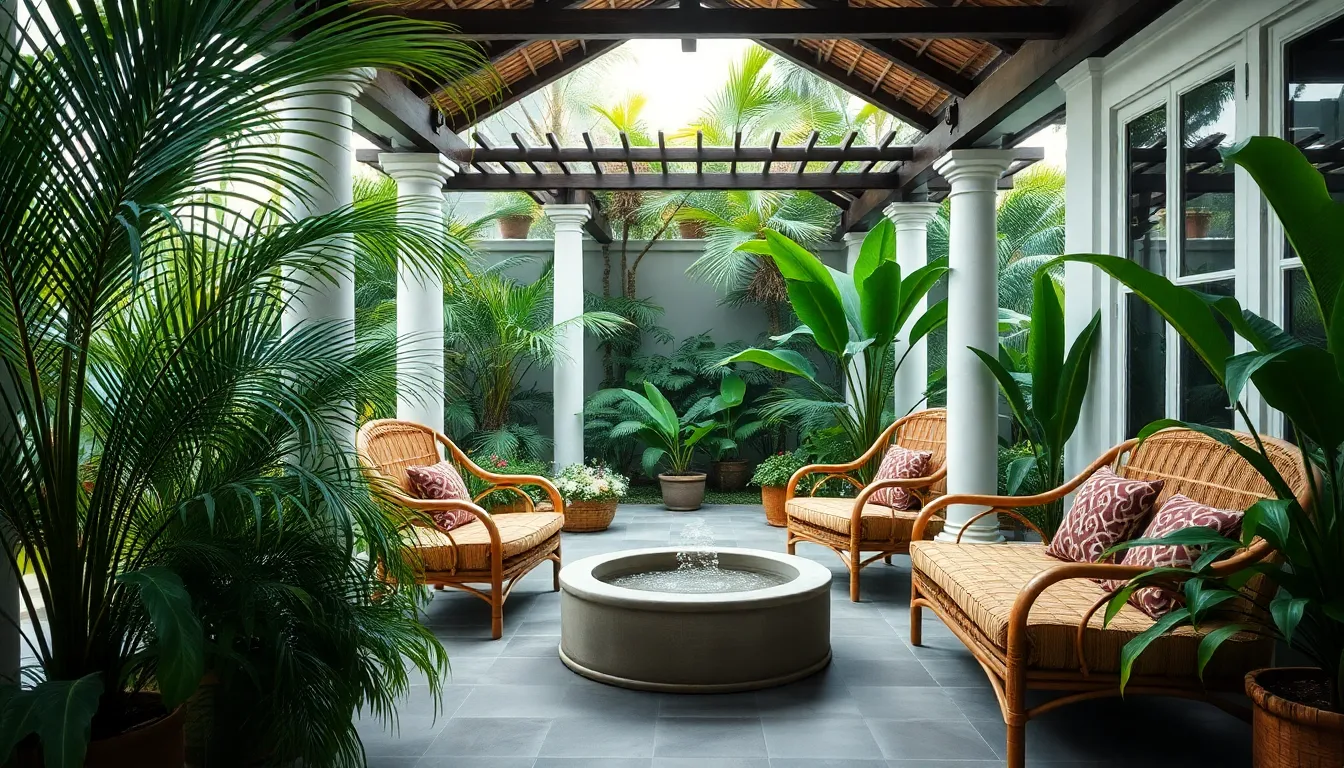
Transforming your garden veranda into a tropical paradise brings the exotic beauty of island living right to your doorstep. We’ll explore natural materials, lush greenery, and water elements that create an immersive tropical retreat.
Bamboo and Natural Materials
Bamboo serves as the foundation for authentic tropical veranda design, offering sustainability and natural warmth that synthetic materials can’t match. We recommend incorporating bamboo furniture, screens, and flooring to establish organic texture throughout your space. Rattan and wicker complement bamboo beautifully, creating inviting seating areas that blend seamlessly with outdoor surroundings.
Reclaimed wood adds rustic charm while supporting eco-friendly design principles. Stone accents provide durability and visual weight that grounds the tropical aesthetic. Natural materials reinforce the connection to nature, making your veranda feel like an extension of the garden rather than a separate outdoor room.
Lush Plant Arrangements
Large leafy plants create the signature abundance that defines tropical garden verandas. We suggest placing palms, ferns, and philodendrons in decorative pots around seating areas to establish layers of greenery. Vertical gardens maximize plant coverage without sacrificing floor space, while hanging planters add overhead lushness that draws the eye upward.
Diverse textures and heights enrich the visual appeal of your plant arrangements. Combine broad palm fronds with delicate fern patterns and glossy philodendron leaves for ever-changing contrast. Strategic placement around furniture creates natural privacy screens while maintaining the open, airy feel essential to tropical design.
Water Feature Integration
Water features amplify the serene atmosphere that makes tropical verandas so relaxing. Small fountains provide gentle background sounds that mask urban noise while creating a resort-like ambiance. Bubbling urns offer compact water elements perfect for smaller verandas, while koi ponds near the veranda create stunning focal points.
Natural integration ensures water features complement rather than compete with your tropical design. Surround fountains with tropical plants and decorative stones for cohesive visual flow. The calming white noise of moving water enhances the peaceful retreat atmosphere, transforming your veranda into a year-round tropical sanctuary.
Install Multi-Level Veranda Structures
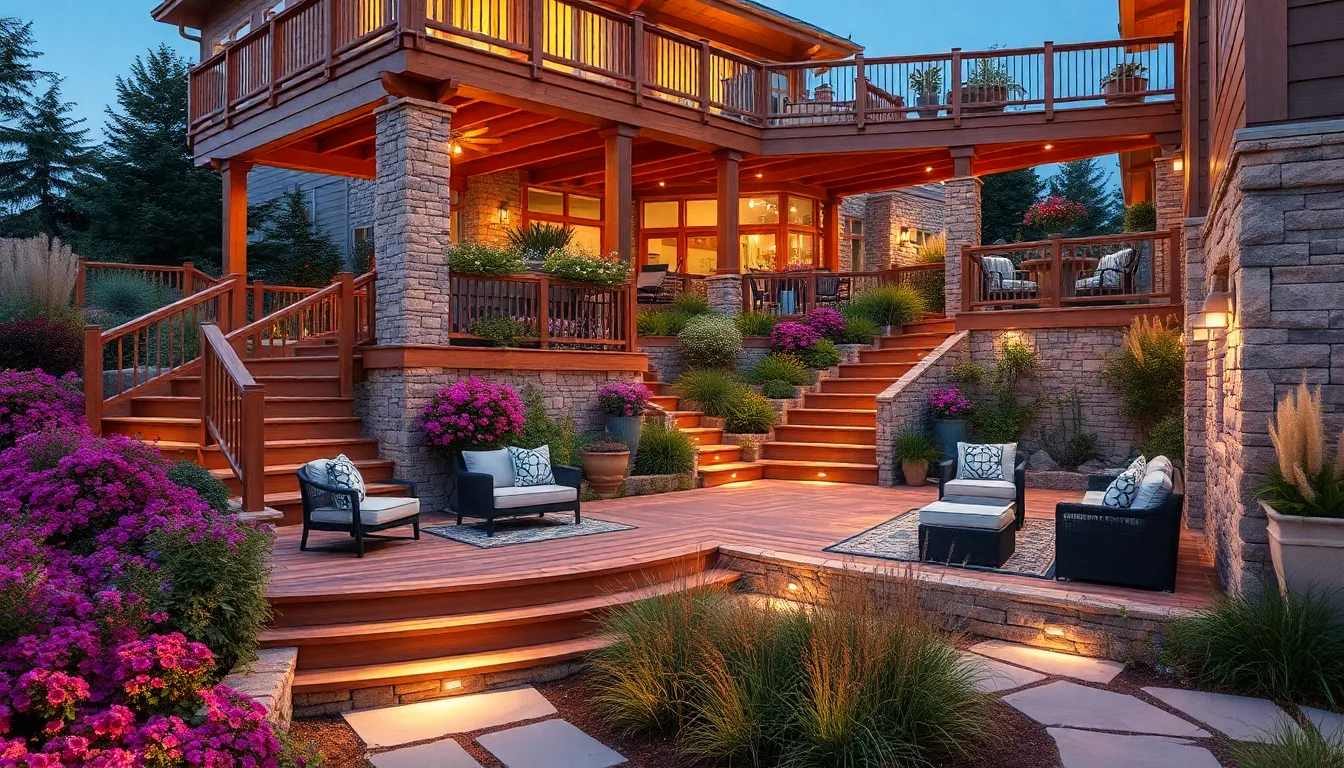
Creating vertical dimension in your garden veranda transforms challenging terrain into functional outdoor paradise. Multi-level structures maximize available space while adding architectural depth that makes smaller gardens appear more expansive.
Tiered Deck Designs
Zoning becomes effortless when we design each tier for exact activities like lounging, dining, or gardening while maintaining visual cohesiveness throughout. Different levels naturally separate spaces without requiring walls or barriers, allowing seamless flow between relaxation and entertainment zones.
Accessibility improves dramatically through graduated steps and gentle slopes that accommodate users of all mobility levels. We recommend incorporating wider landings between tiers to create comfortable transition spaces that double as additional seating or display areas for potted plants.
Visual interest multiplies when we combine materials like wood decking with stone retaining walls or composite platforms with natural rock accents. Each tier can feature complementary textures while maintaining the overall design theme, creating depth that draws the eye upward through the garden space.
Built-in planters between tiers establish natural boundaries while adding greenery that softens the structured edges. We suggest incorporating these planter boxes at varying heights to create cascading garden displays that enhance the tiered effect.
Connecting Stairways and Walkways
Seamless transitions connect different veranda levels through carefully planned stairways that enhance both safety and visual appeal. We design these pathways to follow natural sight lines, guiding movement while highlighting key garden features along the route.
Material continuity strengthens the overall design when we use weather-resistant wood, stone, or composite materials that complement the main veranda structure. Matching or coordinating materials create visual harmony while ensuring long-term durability against outdoor elements.
Strategic lighting guides evening navigation while creating ambient atmosphere throughout the multi-level space. We recommend installing LED strip lights along stair edges and pathway borders to highlight transitions without overwhelming the natural garden setting.
Surrounding landscaping softens hard edges of stairways and walkways through strategic placement of ornamental grasses, flowering shrubs, and ground cover plants. These green elements create natural borders that define the circulation paths while adding seasonal color and texture.
Varied Seating Areas
Functional diversity emerges when we install different seating types across various veranda levels, creating distinct zones for intimate conversations, family dining, and solo relaxation. Each level can accommodate exact furniture scales that match the intended use and available space.
Comfort enhancements include weather-resistant cushions, outdoor rugs, and textiles that add softness and style to each seating area. We layer these elements to create inviting spaces that encourage extended outdoor enjoyment regardless of the weather conditions.
Style personalization reflects individual preferences through furniture selections ranging from rustic wooden benches to sleek modern loungers or Mediterranean-inspired dining sets. Each tier can showcase different aspects of your design personality while maintaining overall visual coherence.
Flexible arrangements allow seasonal adjustments and activity-exact configurations across the multi-level veranda. We design seating layouts that can adapt to different group sizes and entertainment needs, maximizing the functionality of each elevated platform.
Create Enclosed Veranda Spaces
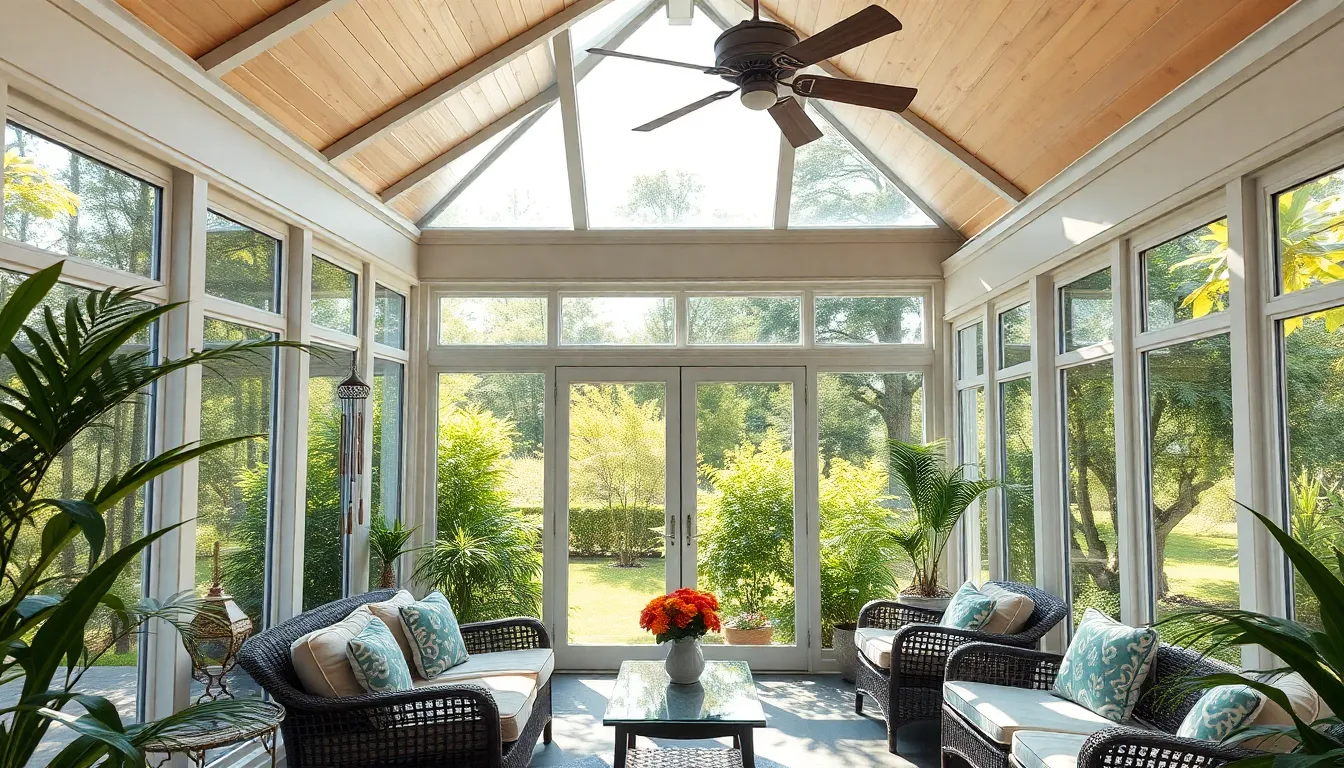
Building on the foundation of stunning veranda designs, we’ll explore how to transform your open space into a protected sanctuary that extends your living area throughout the year.
Screen Room Options
Screen rooms offer the perfect balance between outdoor freedom and indoor comfort for your garden veranda. We recommend installing removable screens that allow you to easily convert your space during different seasons, providing ventilation while keeping insects at bay during warm weather months.
Materials for screen room construction include durable aluminum frames with fiberglass or polyester mesh screening for long lasting protection. Professional installation typically costs between $1,200 to $3,500 depending on the size and complexity of your veranda structure.
Decorative elements enhance the functionality of your screened space significantly. Wind chimes create gentle sounds that complement garden ambiance, while outdoor artwork adds visual appeal without compromising the protective screening benefits.
Ventilation systems work exceptionally well in screened verandas because they maintain airflow while blocking unwanted pests. We suggest positioning ceiling fans strategically to maximize air circulation and create comfortable temperatures during summer entertaining.
Glass Panel Installations
Glass panels transform garden verandas into sophisticated sunrooms that function year round regardless of weather conditions. These installations allow maximum natural light penetration while providing complete protection from rain, wind, and temperature fluctuations.
Installation options include tempered glass for safety, laminated glass for noise reduction, and low E coatings for energy efficiency. Professional glass panel systems range from $2,500 to $8,000 depending on the square footage and glass specifications you choose.
Climate considerations make glass panels ideal for both warm and cold regions because they create controlled environments. Southern exposures benefit from tinted glass that reduces heat buildup, while northern installations maximize solar gain during winter months.
Maintenance requirements for glass panels include regular cleaning and occasional seal inspections to ensure weather tight performance. We recommend professional cleaning twice yearly to maintain crystal clear views of your garden industry.
Seasonal Conversion Features
Seasonal adaptability extends the usability of your enclosed veranda throughout changing weather patterns and temperature variations. Spring and summer configurations focus on maximizing airflow by using lightweight screens or removing glass panels entirely for natural ventilation.
| Season | Configuration | Materials | Benefits |
|---|---|---|---|
| Spring/Summer | Lightweight screens | Removable mesh panels | Maximum ventilation |
| Fall/Winter | Glass panels | Insulated glazing | Weather protection |
| Year-round | Combination system | Interchangeable components | Ultimate flexibility |
Fall and winter preparations involve installing glass panels or heavier screens that provide insulation and weather protection during harsh conditions. Combination systems offer the ultimate flexibility by incorporating both screening and glazing options that interchange based on seasonal needs.
Automated conversion systems represent the premium solution for seasonal adaptability, featuring motorized panels that adjust with the touch of a button. These systems typically cost $5,000 to $12,000 but provide unmatched convenience for homeowners who frequently modify their veranda configuration.
Storage answers become essential when managing seasonal conversion components, requiring dedicated space for screens, glass panels, and hardware during off seasons. We recommend weatherproof storage cabinets positioned near the veranda for easy access during conversion periods.
Integrate Outdoor Kitchen Veranda Concepts
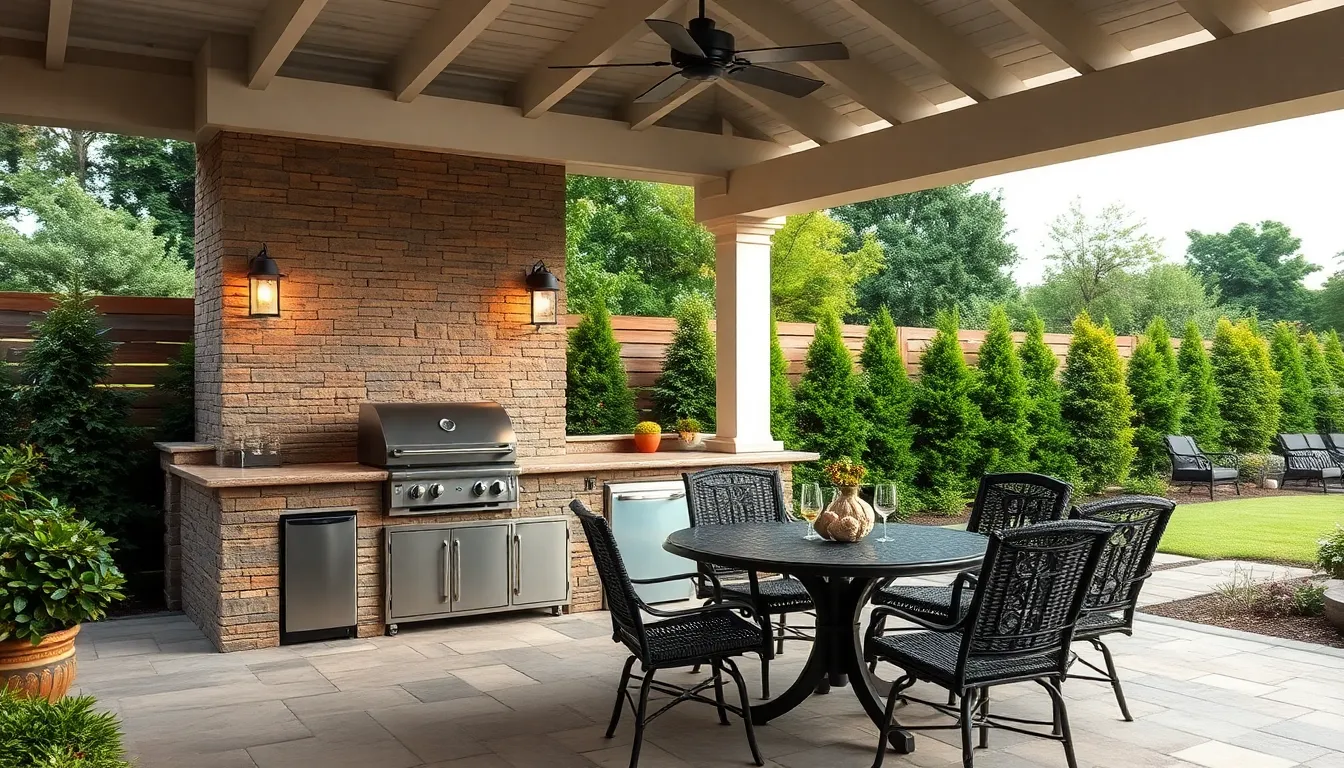
Creating seamless indoor-outdoor living spaces, outdoor kitchen verandas transform your garden into a year-round culinary destination. Weather-resistant designs with pergola coverage or roofed patios extend usability across different seasons while maintaining views toward natural landscapes.
Built-In Grilling Stations
Built-in grilling stations serve as the centerpiece of outdoor kitchen verandas, featuring wood ovens and multiple grills for diverse cooking options. Installing sinks and prep areas alongside your grilling station improves functionality and creates convenient cooking workflows. Natural stone and wood finishes harmonize with both rustic and modern garden designs, ensuring your grilling area complements the surrounding industry.
Positioning your grilling station to face the garden enhances the connection to your outdoor environment while you cook. Strategic placement allows the chef to interact with guests while preparing meals, creating an captivating social atmosphere. Quality materials like natural stone countertops provide durability and visual appeal that withstand outdoor elements year-round.
Dining and Entertainment Areas
Adjacent dining areas with weatherproof furniture encourage socialization and transform your veranda into a multifunctional entertainment space. Bar seating integrated opposite kitchen counters creates interactive zones where guests can engage directly with the cook during meal preparation. Interactive layouts maximize the social potential of your outdoor kitchen while maintaining clear traffic flow.
Fire pits and comfortable seating clusters extend entertainment options beyond dining, creating cozy gathering spots for evening relaxation. String lights and ambient lighting systems enhance the outdoor entertaining experience through strategic placement around dining and seating areas. Multiple seating configurations accommodate different group sizes and activities, from intimate dinners to larger social gatherings.
Storage Answers
Outdoor kitchen verandas benefit from comprehensive storage systems including upper and lower cabinets to organize grilling tools, serving platters, and cooking utensils. Weatherproof cabinetry materials like teak and mahogany maintain organization while protecting contents from outdoor elements throughout different seasons. Quality materials ensure longevity and complement the natural outdoor aesthetic of your garden veranda.
Efficient storage design maximizes space usage while keeping cooking areas tidy and visually appealing for entertaining. Upper cabinets provide convenient access to frequently used items while lower storage accommodates larger equipment and seasonal accessories. Strategic cabinet placement maintains clean sightlines toward garden views while ensuring everything remains within easy reach during cooking and entertaining activities.
Establish Cozy Reading Nook Verandas
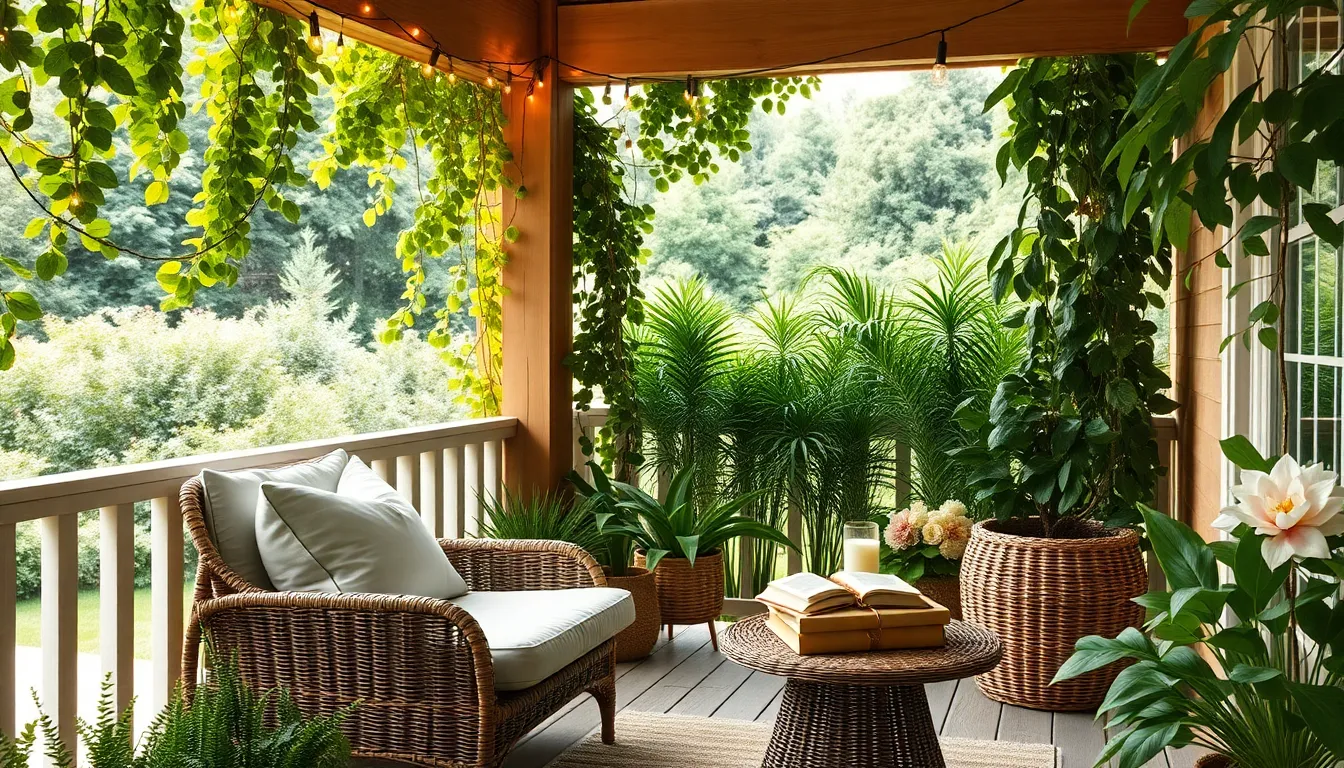
Transforming your garden veranda into a peaceful reading retreat creates a perfect escape from daily life. We’ll explore essential elements that turn any veranda corner into your favorite literary sanctuary.
Comfortable Seating Arrangements
Choose lounge chairs or hammocks as the foundation of your reading nook veranda, positioning them in shaded corners for maximum comfort. Cushioned sofas provide excellent support for longer reading sessions, while rocking chairs add gentle movement that enhances relaxation. Weather-resistant textiles like outdoor cushions and throws increase comfort levels significantly throughout different seasons.
Mix materials strategically by combining wood, wicker, and metal furniture pieces to balance durability with visual appeal. Modular outdoor furniture offers flexibility when you want to reconfigure your space for guests or different activities. Built-in benches with storage compartments maximize functionality while maintaining the cozy atmosphere essential for reading retreats.
Add soft furnishings including outdoor rugs and decorative pillows to create layers of comfort that invite extended reading sessions. Side tables positioned within arm’s reach hold books, beverages, and reading accessories without disrupting your comfortable position. Ottoman-style seating doubles as footrests and additional surface space for your reading materials.
Privacy Screening Options
Install natural screens using tall planters filled with lush greenery to create intimate boundaries around your reading nook. Trellises with climbing vines like jasmine or clematis provide living walls that enhance privacy while adding natural beauty. Bamboo panels offer an Asian-inspired aesthetic that creates effective screening with minimal maintenance requirements.
Incorporate vertical gardens that serve dual purposes by adding privacy screening while introducing vibrant colors and textures to your space. Hanging planters with trailing plants create natural curtains that filter views without completely blocking airflow. Tall ornamental grasses in large containers establish gentle barriers that move gracefully with garden breezes.
Use weather-resistant curtains made from outdoor fabrics that provide flexible privacy options you can adjust based on reading preferences and weather conditions. Retractable screens offer seasonal adaptability, allowing full openness during pleasant weather and protection when needed. Privacy hedges using fast-growing shrubs create permanent screening that improves with time and seasons.
Ambient Lighting Ideas
String lights create magical ambiance for evening reading sessions, with LED options providing energy-efficient illumination that extends your veranda’s usability into nighttime hours. Japanese lanterns contribute to cozy atmospheres while offering practical task lighting for reading materials. Solar-powered fixtures eliminate electrical concerns while maintaining consistent lighting throughout garden seasons.
Position table lamps strategically to highlight reading areas without creating harsh shadows that strain your eyes during extended sessions. Small accent lights can illuminate architectural features of your veranda while providing subtle background illumination. Candles in hurricane glass holders add romantic ambiance while protecting flames from garden breezes.
Layer lighting sources by combining overhead string lights with focused reading lamps to create versatile illumination options for different times and moods. Motion-sensor lights enhance safety along pathways leading to your reading nook without disturbing the peaceful atmosphere. Integrated lighting systems allow you to adjust brightness levels based on natural light conditions and reading requirements.
Design Eco-Friendly Sustainable Verandas
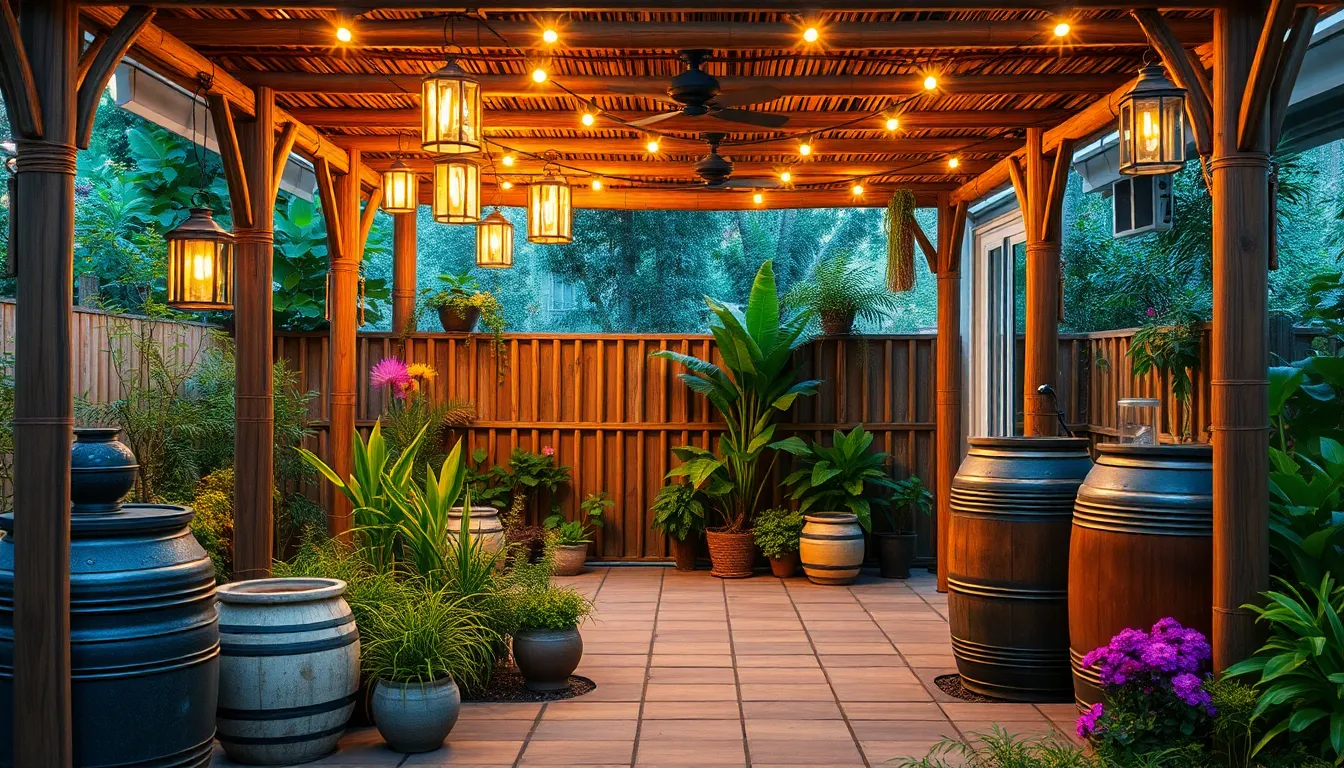
We can create beautiful outdoor spaces while protecting our environment through thoughtful material choices and sustainable design practices.
Green Building Materials
Bamboo stands out as one of the most sustainable options for veranda construction due to its remarkable durability and natural resistance to pests. This fast-growing material regenerates quickly and offers exceptional strength that rivals traditional hardwoods.
Reclaimed wood brings character and environmental benefits to our veranda projects by reducing waste while adding rustic charm. Each piece tells a story through weathered textures and unique grain patterns that new lumber simply can’t replicate.
Sustainable wood species like cedar, redwood, and pine provide natural resistance to decay and rot without requiring chemical treatments. These materials offer longevity and beauty while supporting responsible forestry practices that protect our forests for future generations.
Solar Power Integration
Solar powered lighting transforms our verandas into magical evening spaces without requiring complex electrical installations. Solar lanterns and stake lights provide soft ambient glowing throughout the night while charging naturally during daylight hours.
Solar panels installed on pergola roofs or veranda structures can power various outdoor features including water fountains, string lights, and charging stations. These installations reduce our carbon footprint while providing reliable energy for outdoor entertainment and relaxation.
Strategic placement of solar components maximizes energy collection while maintaining the aesthetic appeal of our sustainable veranda design. We can integrate these systems seamlessly into existing architectural elements without compromising visual harmony.
Rainwater Collection Systems
Rain barrels offer an efficient solution for collecting and storing rainwater that would otherwise flow away from our properties. These systems provide free water for irrigation and other non potable uses while reducing strain on municipal water supplies.
Drip irrigation systems connected to collected rainwater deliver precise watering to our veranda plants while minimizing waste. This efficient method ensures our gardens thrive while conserving this precious natural resource.
Integrated collection systems can be designed to complement our veranda’s aesthetic while serving practical water conservation purposes. We can incorporate decorative rain chains and attractive storage containers that enhance rather than detract from our outdoor living spaces.
Conclusion
We’ve explored many garden veranda possibilities that can transform your outdoor living experience. From classic wraparound designs to contemporary minimalist approaches each style offers unique benefits for different preferences and budgets.
The key to success lies in choosing elements that complement your home’s architecture while reflecting your personal lifestyle needs. Whether you’re drawn to rustic farmhouse charm or sleek modern aesthetics the right combination of materials and features will create your perfect outdoor sanctuary.
Don’t forget to consider sustainable options that benefit both your wallet and the environment. Solar integration and eco-friendly materials aren’t just trendy choices—they’re smart investments that add long-term value to your property while reducing your environmental footprint.
Your garden veranda awaits and with these ideas you’re well-equipped to create an outdoor space that’ll serve as your favorite retreat for years to come.
Frequently Asked Questions
What is a garden veranda and how does it enhance my home?
A garden veranda is an outdoor living space that combines indoor comfort with outdoor beauty, typically featuring a covered porch or patio area. It enhances your home by adding value, creating a relaxing sanctuary, and providing a seamless transition between indoor and outdoor living spaces.
What are the most popular veranda design styles?
Popular veranda styles include classic wraparound designs with traditional railings, modern minimalist verandas with geometric elements, rustic farmhouse styles with weathered materials, Mediterranean designs with terracotta accents, and tropical paradises featuring natural materials and water features.
Can I create a veranda on any budget?
Yes, garden verandas can be designed for various budgets. Options range from simple DIY projects using reclaimed materials to elaborate multi-level structures. Focus on essential elements first, then add features over time as your budget allows.
What materials are best for eco-friendly verandas?
Sustainable materials include bamboo, reclaimed wood, recycled composite decking, and locally sourced stone. These options offer durability and character while reducing environmental impact. Consider materials that require minimal maintenance and have long lifespans.
How can I make my veranda usable year-round?
Install screen rooms for bug protection, glass panels for weather shielding, and proper roofing for rain coverage. Add heating elements, outdoor lighting, and weather-resistant furniture to extend usability throughout all seasons.
What features can I add to make my veranda more functional?
Consider adding outdoor kitchens for entertaining, cozy reading nooks for relaxation, multi-level structures for different activities, solar lighting for energy efficiency, and rainwater collection systems for garden irrigation.
How do I choose the right roof configuration for my veranda?
Select roofing based on your climate, desired protection level, and aesthetic preferences. Options include traditional pitched roofs, flat modern designs, pergola-style partial coverage, or retractable awnings for flexibility.
Can I integrate sustainable features into my veranda design?
Absolutely! Install solar lighting and power systems, rainwater collection for irrigation, use green building materials, incorporate native plants, and design for natural ventilation to reduce energy consumption and environmental impact.

